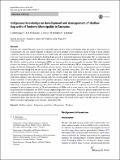| dc.description.abstract | Dodoma city, central Tanzania, seats in a semi-arid region of East Africa with limited rains and surface water resources.
Consequently, the area largely depends on shallow and deep aquifers for its freshwater needs. Owing to harsh climatic
conditions, chronic lack of year-round surface water bodies and, limited development of water distribution infrastructures,
over year’s local people have nurtured, developed and, passed on important indigenous knowledge (IK) on exploiting and
managing shallow aquifers (SAs). However, there is no clear documented administrative plans for the SAs and the roles of
IK, which is widely practised in developing SDWs and managing SAs, are not properly documented. This study intended
to assess the extent of shallow dug wells (SDWs) utilization and contribution of IK on management of SAs of indigenous
people of Dodoma Municipality. The methods followed include critical feld observations, measurements and, focus group
discussions done during both the dry season (Sep.–Oct. 2013) and wet season (Dec. 2013–Feb. 2014). The results show
that SDWs occur widely in the city, particularly in the suburbs, where they often serve as the only sources of freshwater
and heavily dependent by the populace. It is clear that there is rich IK on management of SAs including on groundwater
exploration, digging, water allocation, pricing, and even on water quality and, water treatment skills. The aforementioned IK
clearly contribute to water sufciency to the populace and general management of groundwater such as enhancing recharge
mechanisms where about 1% of local rainfall is recharged through a network of SDWs compared to~ 5–10% that is naturally being recharged by rainfall through the vadose zone. Thus, as much as the current policy framework and groundwater
managers do not recognize the roles of IK and contributions of SDWs as key water sources, it is clear that IK contributes to
the groundwater management and SDWs already support large part of the society. While it is globally appreciated that vital
skills on SDWs management are vanishing, local people in Dodoma still retain them and should, therefore, be preserved. It
is further recommended that IK are strengthened, improved and most importantly, incorporated in the local water resources
management plans that already advocate on integrated approaches but which clearly ignores the IK and the local people’s
eforts to explore and manage water resource, particularly SAs. | en_US |

